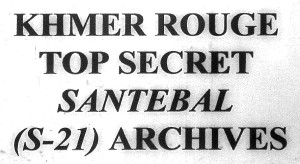The digitization of historical materials is making research ever more easy, however I still find that I make my greatest “discoveries” by looking around in actual libraries.
Today, for instance, I was in a library and came across a few reels of microfilm of “Khmer Rouge top secret Santebal (S-21) archives.”
I had never heard of these materials, but upon looking at them, I was fascinated to see the kind of documents that they contain.
The first thing that I noticed was the prevalence of tables (information that today we would put in Excel charts).
Some scholars have characterized the Khmer Rouge effort to transform Cambodian society as a “high-modernist” project, and the intense effort to document information in tabular form (and thereby making it more easily visible by the state authorities) struck me as a good example of this phenomenon.
My knowledge of Khmer is pretty bad at the moment, but it looks to me like some of these tables are recording inventories of things like bullets and guns. That may not sound very interesting, but examining documents like this could provide interesting insights into the strength of the Khmer Rouge, as well as the way that they sought to control their own forces.
From a Google search about this archive, I see that hundreds of reels of microfilm of Khmer Rouge documents were made in the late 1990s and early 2000s by the Southeast Asia Collection of Yale University Library and the Documentation Center of Cambodia (good job!!!).
In addition to Khmer Rouge documents, some of these reels of microfilm also contain documents from the Lon Nol regime about the Khmer Rouge before they came to power in 1975.
The Khmer Rouge period is a topic that has been written about extensively, but these thousands upon thousands of pages of documents offer the opportunity to say something new about that period of history.
It would be great if someone with strong Khmer language skills would make the effort to do so.





This Post Has 9 Comments
Australian scholar Ben Kiernan who wrote the definitive histories of Pol Pot and the Khmer Rouge, is Director of the MacMillan Center at Yale University in the United States. Kiernan led the effort to copy and make available to the public the Khmer Rouge archives discovered in the Cambodian Ministry of Information in 1996. This treasure trove of date and information was especially useful to me in writing my new book “Four Faces of Truth” (Fireship Press) which deals with the rise and deadly legacy of the Khmer Rouge regime. I believe that what you found in the library is from the same archives. Harriette Rinaldi
Thanks for the comment. So these materials were in the “Cambodian Ministry of Information” in 1996, but are they specifically about S-21, or are they about more than that?
Also, your book looks interesting. I’m tired of reading the same things about that period, but I see that you had a unique exposure to Cambodia in the early 1970s. The immediate pre-KR years tend to get glossed over, so I look forward to seeing what you have brought from that period into your book.
This material contains details on all aspects of the Khmer Rouge regime’s activities.You can gain access to this valuable collection from the Yale University Cambodian Genocide Program at http://www.yale.edu/cgp/. These archives have been especially useful for the work of the Documentation Center of Cambodia (DC/CAM) whose goal is to educate the Khmer people about the crimes of the Khmer Rouge–which today’s rulers encourage people to forget. Thank you for your interest in my book. This is much appreciated. Harriette
Thanks, and yes, I remember finding this page before.
http://www.yale.edu/cgp/santebal_microfilms.html
The multiple reels of microfilm containing the “Lon Nol dossier” must have some fascinating stuff!!
I know Khmer pretty well but so far have been unable to track down legible scans of the documents. I e-mailed Ben Kiernan and am awaiting his response. I am an independent researcher with limited funds, so hopefully there is an affordable way for me to access these documents and make them more widely available.
I scanned the images here from microfilm. So for that you need (a library with) a microfilm reader that can scan.
I don’t know what kind of copyright issues might be involved, but it would be great to digitize those materials and put them online.
Just go to the Yale University Cambodian Genocide Project at http://www.yale.edu/cgp and search under Date Bases. You’ll find what you’re looking for there online.
Are you sure about this? I think there were about 20 or more reels of microfilm. Even if that’s all one there, 1) this database is not very easy to use (no browse function, for instance), and 2) the quality of the scans that I was able to find were quite poor. This database may have been good at the time that it was created, but the times are changing fast.
Your best source of information will probably be the Documentation Center of Cambodia whose director is Youk Chhang. His e-mail address is dccam@online.com.kh. I hope you can find your answers there! Harriette